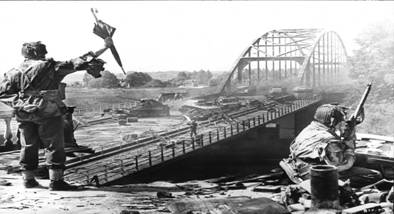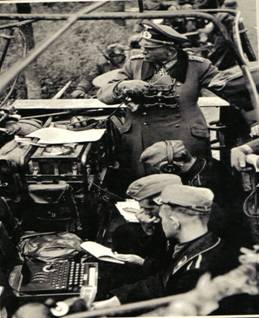The Y Service 1939-1945
‘Y' Service Operations in Market Garden
September 1944

Market Garden was the name given to the boldest advance of infantry and airborne troops ever in the history of warfare to date, which took place across the northern part of Belgium to the Lower Rhine, north east of Arnhem, Holland. Market was the name given to the advance of XXX (30) Corps with armoured units supported with infantry and others units within XXX Corps for its part was to drive 60 miles along one road. And to link up with the Garden part of the operation, this part was to be the airborne troops, part of the operation for these troops were to take and hold the bridges at Eindhoven which was to be taken by the 101 st U.S Airborne Division then onto Nijimegen where the 82 nd U.S Airborne was to take and hold the bridge and onto Arnhem where the 1 st British Airborne was to take the bridge. The whole of the operation was planned to take 3 days from the start of the first.
The starting date of the operation was to be the 17th September 1944, from bases in England. The first part of the operation went well for the 101 st at Eindhoven and for the 82 nd at Nijimegen, but the 1 st Airborne at Arnhem the operation was not going well. They had suffered heavy casualties in Arnhem and the surrounding areas of the bridge and for the race to the bridge from the drop zones and gilder landing zones about 10 miles outside of Arnhem.
A Special Wireless Section of ‘Y' Service, (110 SWS) were working with XXX Corps, in the area of Nijmegen. The work of a special wireless section was first above all else TOP SECRET. Their work was to intercept all the enemy's wireless massages to and from as many stations what were possible and also to locate the transmitting stations by use of direction finding equipment with each of the sections. All the members of the these ‘Y' Sections could speak at least two languages and were the only members of the Allied forces that could if necessary transmit to the German forces in Morse code (CW). Due to the slow link up by XXX Corps with 1 st Airborne they had suffered heavy casualties.
It is believed that 110 SW Section were asked by General Browning to try to contact the Germans in Arnhem with a view to arranging a temporary armistice to allow the evacuation of the wounded British and German troops. The first contact was tried by telephone from a shoe factory in the town of Nijimegen to the Germans in Arnhem. But no answer or the lines were down. 110 SW Section then used the D/F (Direction Finding) aerial loops which were fitted to the D/F trailers to find the local German Army wireless transmitter's where the loudest network of German message's, seemed to be coming from the area around the railway station in the town of Arnhem.
One of the operators in 110 SW Section was then asked to contact the German network he worked the station transmitting on a C/W (Continues Wave - Morse Code) frequency. At first they refused to respond but, during the afternoon, presumably having consulted higher authority, they did. There were long pauses between questions and the answer as each side warily studied the other's response, but the exchanges went something like this:

British “This is a message from the British Commanding General to his counterpart.”
German “Pass your message”.
British “In accordance with the Rules of War as set out in Article One of the Geneva Convention I
wish to discuss a cease fire to evacuate my wounded”.
German “What do you propose”?
British That we agree a time during which you will allow my ambulances under your guarantee of
Safe Conduct to evacuate my wounded”.
German “While I would like to be of service to my friend the enemy I fear that some young subaltern
will seize the opportunity to fill your ambulances with armed men.”
British “Then will you use your ambulances to pass my wounded to me under my guarantee of Safe
Conduct”.
German “I regret that I have only sufficient ambulances for my own needs. The R.A.F have bombed all the rest”.
British “Then will you permit the International Red Cross to perform the task”?
German “ You arrange it and we will discuss it further”.
All of this had been conducted in impeccable English, by now it was approaching midnight. The German operator now came up saying “ I have to change frequency now. Good Night”.
British “What frequency will you be using tomorrow so that I can contact you”.
German “ You know I can't tell you that”.
British “How am I going to find you, then”?
German “The same way you found me today”.
The British knew his new frequency anyway due to the “I” Corps (Intelligence Corps) though its predictions. “I” Corps made over many years of inception of German Army wireless transmissions. The station was called several times the following day but the German station refused to respond.
It mattered little as the Mayor of Arnhem arranged the cease-fire so that the wounded could be evacuated but unfortunately not to the British side.
“The fact that these exchanges took place between two opposing Field Commanders rather than their GOC's (General Officer Commanding) and the improper use of the ‘Y' Service, might explain why no official record exists for far. The story was told to the writer of this article by the men who served with 110 SW Section at the time.”
This incident had a sequel a few days later, When General Urquhart. 1 st Airborne Division Commander joined the D/F unit. His HQ had been called by a station purporting to be the remnants of one of his battalions calling for assistance to break out and rejoin the Division. Not an unlikely situation given the nature of their battle, but before responding General Urquhart wanted some assurance this was not a German ruse to lure him into an ambush.
His doubt arose from the operator's using a 5 or 6-day-old call sign and code, this would have been OK had his call sign /codebook been destroyed in the fighting or if the operator's feared capture by the enemy.
The D/F unit set the ball rolling by asking his name, rank, serial number and unit. Which were all answered satisfactorily. The operator serial number told the D/F – I Corps that he was not a Royal Signals operator and that he must be a Regimental signaller with a top Morse code speed of about 12 (wpm) words per min. When asked to explain his use of out of date call sign, he give the response that he had been in heavy fighting and was ordered to destroy his call and cipher book the fighting had gone on for a few days and this was the only position where he could transmit safely.
Over the next few hours the D/F operator gradually increased his sending speed to over 20 wpm which the Regimental signaller responded to ok. At the same time the other D/F operators were getting a good D/F bearings on the transmitting station. At the same time of the increase in Morse speed the D/F operator began putting in the occasional International Commercial procedure and eventually the German “Q” signals, which only German operators would have, know. No British operator outside of the ‘Y' Service would be familiar with so this was deemed proof that he was trying to trap the British.
The decision was taken to tell the Royal Artillery to lay down a barrage on the bearings that the D/F unit had got from his transmissions the operators of the D/F unit felt pleased with their work. But a little premature as it turned out the Germans were equally efficient in taking bearings from transmitting stations and returned the fire. The D/F unit were not popular with the neighbouring troops as they too were shelled.
On the 12 th November 1944, General Horrocks addressed the section and observed that they were the oldest member of XXX Corps and thanked them for their work. 15 th November 1944 saw the section moved to St Jean, Brussels and there they were stood down. Most of the men of 110 SWS were sent on to other Special Wireless sections.
Return To Index